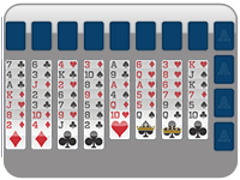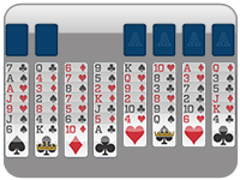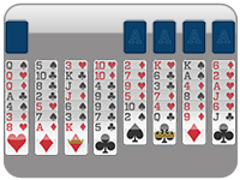Mastering Freecell Strategy: Tips for Winning Every Game

When it comes to card games, Freecell Solitaire is probably one of the most famous. Many people grew up either playing it in physical form, or the version that used to be on all computers in the 90s and early 2000s! While it might look like a simple card game from the outside, underneath the surface you can see a deep, strategic challenge that needs skill and patience. Unlike other solitaire games which often rely on pure luck, Freecell needs other skills like logic in order to win. With this game, every card can be seen from the start which means that every single move is important and every game is (theoretically) winnable if you play your cards right. Whether you are completely new to Freecell, or if you're looking to improve your game, we've put together a guide that will walk you through everything you need to know to master Freecell strategy and hopefully win every game that you play. Keep reading to get inspired and be a champion in no time!
Mastering Freecell: Essential Strategies
As mentioned above, while Freecell might look simple on the surface, there is a lot you need to know in order to nail the strategy. To win, you need to understand its foundation, knowing it's a game of skill, not chance. When you play, all 52 cards are dealt face-up into eight columns, with four free cells and four foundation piles. Your goal is to essentially get all the cards to the foundation piles, sorted by suit and in ascending order from Ace to King.
The essential strategies you need for mastering Freecell include:
Plan Before You Move
Before making your first move, take a moment to analyse the entire board. Identify key cards (especially Aces and Twos) that you'll need to free early. Avoid impulsive moves that only shuffle cards around without improving your position as this just wastes time and moves.
Keep the Free Cells Free
Free cells act as temporary storage, allowing you to manoeuvre cards. However, the more cells you fill, the fewer moves you can make. Always try to keep at least one or two free cells open at all times, they are your emergency tools, not permanent parking spots and will come in handy the more you play.
Build Columns Carefully
Build down in alternating colours, but don't just follow this rule mechanically. Think ahead: moving a red 6 onto a black 7 might seem fine now, but does it block an important sequence? Always consider the long-term consequences of each stack. If you think in the short term, you will only end up shooting yourself in the foot in the long run. It's better to be careful and make every single move count, rather than try to rectify any moves you've made later on.
Focus on Empty Columns
Empty tableau columns are your most powerful assets. They let you move entire sequences of cards, giving you much greater flexibility. Prioritise clearing columns as early as possible, and then use them strategically to reorder your cards. This will be a great help for the rest of the game.
Top Tip to Dominate Freecell Every Game
While it might sound ambitious to want to win every game of Freecell that you play, with the right approach it's certainly a lot more achievable than you might think. Soon you'll be impressing everyone you know with your skills! Here are some of the top tips that will enable you to dominate Freecell every game and even if you don't win every single one, you will certainly be close! (After all, where would the fun be if it was too easy!)
1. Free the Aces and Twos Early
Your first priority should always be to uncover and move the Aces and Twos to the foundation piles. This immediately frees up more moves and opens the game.
2. Don't Move to the Foundation Too Early
It's tempting to move cards to the foundation as soon as possible, but be careful, sometimes you'll need those low cards to build sequences in the tableau. Wait until you're sure it won't restrict future plays and then you can go ahead and do this.
3. Maximise Mobility
Every move should increase your flexibility. If you can choose between several options, go with the one that gives you more potential moves in the next few turns. You'll soon see what a difference this makes for you!
4. Think in Sequences, Not Single Cards
Instead of thinking about individual cards, visualise entire sequences. The ability to shift an entire run of alternating colours is key to rearranging the tableau effectively. This can be difficult to always try and be a few steps ahead, but it will really pay off.
5. Use Undo and Rewind Wisely (If Playing Digitally)
In digital Freecell versions, the undo button is your best friend. Use it to experiment, test different sequences, and identify better strategies. Real masters learn from their mistakes in real time. This will help you to learn where you're going right in your strategy, how to improve, and things you can do differently. The best way to learn is through mistakes, so let this help you do just that and get better and better until you don't need that undo button!
Advanced Freecell Tactics for Skilled Players
Once you've mastered the basics, you can start using advanced Freecell tactics that allow you to handle even the trickiest layouts. These techniques are what elevate good players into unbeatable ones.
Chain Moves with Free Cells and Empty Columns
The number of cards you can move at once is limited by how many free cells and empty columns you have. For example:
- With 1 free cell, you can move 2 cards.
- With 2 free cells, you can move 3 cards.
- With 3 free cells, you can move 4 cards.
- With 1 empty column, the number of movable cards doubles.
Mastering this relationship allows you to chain moves efficiently, turning tight situations into smooth wins.
Reverse Building to Clear Key Cards
Sometimes you'll need to build a sequence that seems counterproductive, such as stacking in the "wrong" colour order just to reach a buried card. Reverse building can temporarily block progress but ultimately unlocks key pathways. Once you are more in the know with how the game works, you will recognize patterns like this that can really help you to get ahead, even if it doesn't feel like it at the time!
Reserve Free Cells for Kings
Kings take up the most space in the tableau, so plan ahead. Before moving a King into an empty column, make sure you'll be able to build under it, otherwise, you're wasting a valuable column. If you move a King and you can't build beneath it, it's counterproductive and will just end up wasting time and also the number of moves you play.
Manage Suits Separately
Instead of trying to build evenly across all suits, focus on one or two at a time. This creates momentum and opens the board faster. You want the board to be open so you have more options as you go, and this will make such a difference.
Practice Pattern Recognition
Over time, you'll start to recognise common layouts and problem areas. For instance, when all Aces are deeply buried, you'll know to prioritise freeing them before doing anything else. It's this sort of thing that you can only learn through time and the more games you play, so perseverance will pay off! You will soon find you recognise these movements and learn what you can do to free certain cards and what to do first over other moves within the game you're playing.
Beginner's Guide to Freecell Solitaire
If you're new to Freecell, don't worry, we were all there at one point! It can feel a bit daunting learning a new game and it can feel there are so many elements you need to be aware of and tactics to remember. However once you've played a few times, you will become accustomed to what exactly you need to do, and how to do it. Here are some of the fundamentals you need to be aware of:
How Freecell Works
You have:
- 8 tableau columns (the main play area)
- 4 free cells (temporary holding spaces)
- 4 foundation piles (where completed suits go)
You can move one card at a time, but sequences of alternating colours can be moved together if you have enough free cells or empty columns.
The Goal
Move all cards to the foundation piles in ascending order by suit (Ace through King).
Step-by-Step Starter Strategy
- Scan the tableau to locate Aces and Twos.
- Move Aces to foundations when possible.
- Uncover buried low cards early.
- Use free cells sparingly.
- Create an empty column and keep it open as long as possible.
- Build sequences smartly — always alternating colours and thinking ahead.
Common Beginner Mistakes
- Filling all free cells too early.
- Moving Kings into empty spaces without a plan.
- Building too many short sequences that block key cards.
Remember: in Freecell, every move should serve a purpose.
The Best Freecell Moves Explained
One of the most important things in Freecell is understanding not only what the best moves in Freecell are, but also when and why to make them. By doing so, you'll learn how you can improve and where to play your cards in the future for the maximum impact. Some of the most effective types of moves are:
The "Setup" Move
This move clears space or positions cards to allow a bigger move later. It's about foresight, not immediate results.
The "Cascade" Move
Using multiple free cells and empty columns to move a long sequence at once. This is the hallmark of advanced play — it takes planning, but it's incredibly satisfying.
The "Foundation Buffer" Move
Sometimes, you can move cards to the foundation temporarily to free up moves, then adjust later. Be careful, though — you can't undo a foundation move in all versions of the game.
The "Cycle" Move
Rotating cards through the free cells or tableau to free up a trapped sequence. It might take three or four intermediate moves, but the payoff is a clear path to the foundation.
The "Column Reset" Move
When a column is blocked, you can dismantle it piece by piece, move the necessary card, and rebuild it more efficiently. This kind of move separates skilled players from casual ones.
How to Strategically Play Freecell
When it comes to strategically playing Freecell, it's about balancing your immediate gains with long-term positioning in order to succeed. Some of the best ways you can do this include:
Step 1 - Analyse the Tableau
Before you move anything, take the time to look and analyse the board in front of you. Look for things such as buried Aces and Twos, long alternative colour sequences and potential empty columns that you can utilise.
Step 2 - Prioritise Progress instead of perfection
Don't try to build perfect columns right away, instead make steady progress and make sure that every move counts.
Step 3 - Keep the board open
Avoid stacking too many high cards or closing off columns prematurely. Open spaces mean power and this can be your in to win!
Step 4 - Visualise future moves
You should make sure to always think at least 2-3 moves ahead, with every decision you make setting you up for the next one.
Winning Freecell: Rules and Tips
Basic Rules Recap
- Build tableau columns in alternating colours (red/black).
- Move one card at a time, or sequences if allowed by free cells/columns.
- Move Aces to the foundation as soon as possible.
- You win by moving all cards to the foundation piles in ascending order.
Quick Tips for Guaranteed Improvement
- Plan before every move. Impulsive play is the biggest losing factor.
- Keep free cells open. Only use them as temporary tools.
- Focus on freeing low cards first. This opens up the game.
- Make empty columns your top priority. They multiply your options.
- Practice regularly. Like chess, Freecell rewards experience and repetition.
Freecell is a game of skill, patience and logic, so by learning to recognise the patterns before you and making careful moves, you'll be onto a winner almost every single time.
Freecell Games
More Solitaire Games
More Games
247 Freecell News
Disclaimer
DISCLAIMER: The games on this website are using PLAY (fake) money. No payouts will be awarded, there are no "winnings", as all games represented by 247 Games LLC are free to play. Play strictly for fun.



























